Comprehensive Report: Workplace Transformation Research and Methods
VerifiedAdded on 2022/02/09
|6
|1424
|27
Report
AI Summary
This report delves into the critical aspects of workplace transformation, examining its impact on business success and growth. It begins by exploring the significance of external variables like competition and market dynamics, as well as the influence of internal factors on organizational growth. The research aims to showcase the transformation of the workplace, focusing on objectives such as identifying transformation methods and demonstrating research approaches. The literature review covers a wide range of topics related to digitalization and workplace transformation, analyzing trends and highlighting current research. The methodology involves a theoretical approach, incorporating insights from psychology, organizational behavior, and managerial studies. The anticipated outcome suggests a shift towards digital solutions, empowering the workforce with flexible and strong technology strategies. The report concludes by emphasizing the benefits of workforce transformation, including increased productivity, morale, and improved teamwork.
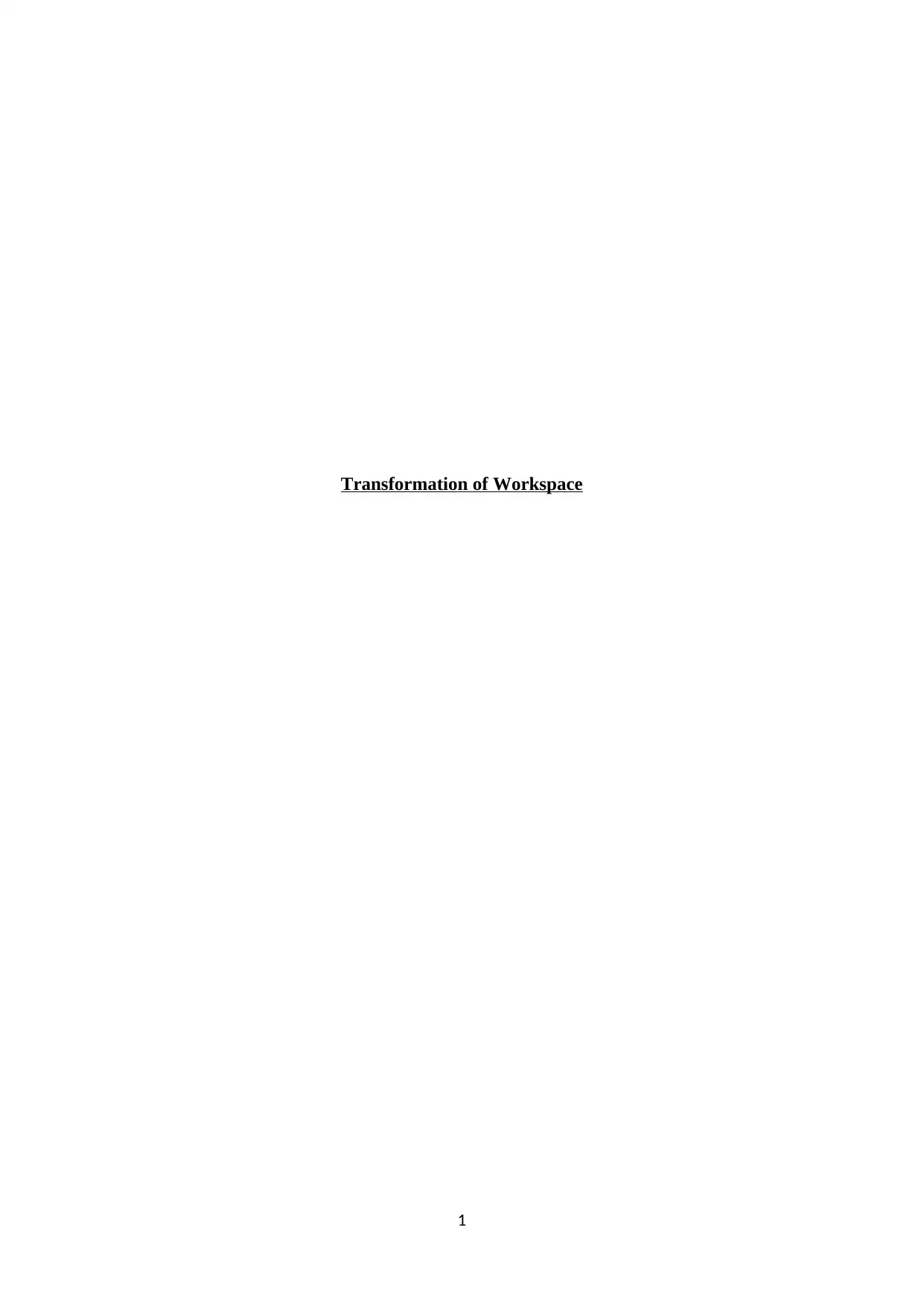
Transformation of Workspace
1
1
Paraphrase This Document
Need a fresh take? Get an instant paraphrase of this document with our AI Paraphraser
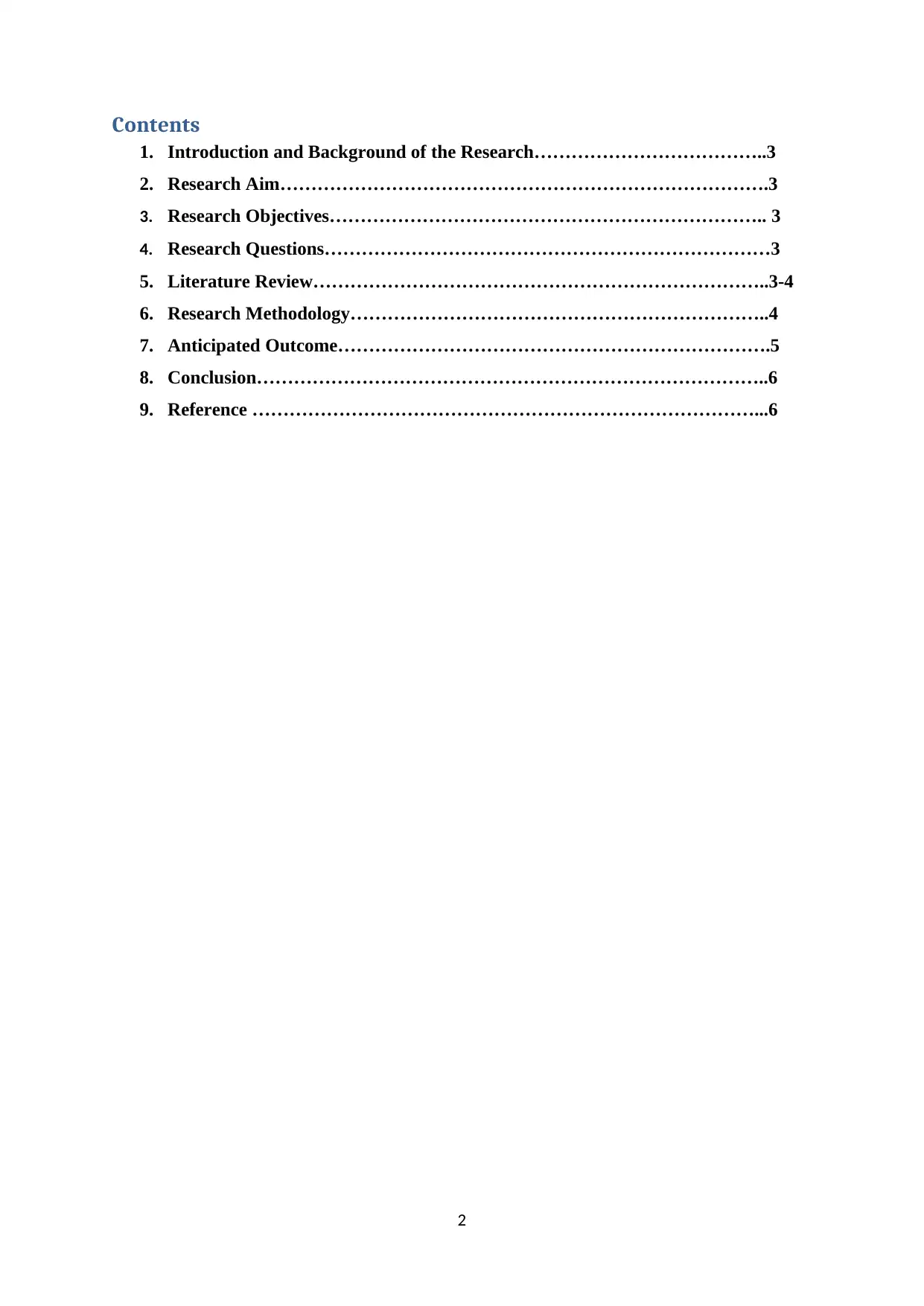
Contents
1. Introduction and Background of the Research………………………………..3
2. Research Aim…………………………………………………………………….3
3. Research Objectives…………………………………………………………….. 3
4. Research Questions………………………………………………………………3
5. Literature Review………………………………………………………………..3-4
6. Research Methodology…………………………………………………………..4
7. Anticipated Outcome…………………………………………………………….5
8. Conclusion………………………………………………………………………..6
9. Reference ………………………………………………………………………...6
2
1. Introduction and Background of the Research………………………………..3
2. Research Aim…………………………………………………………………….3
3. Research Objectives…………………………………………………………….. 3
4. Research Questions………………………………………………………………3
5. Literature Review………………………………………………………………..3-4
6. Research Methodology…………………………………………………………..4
7. Anticipated Outcome…………………………………………………………….5
8. Conclusion………………………………………………………………………..6
9. Reference ………………………………………………………………………...6
2
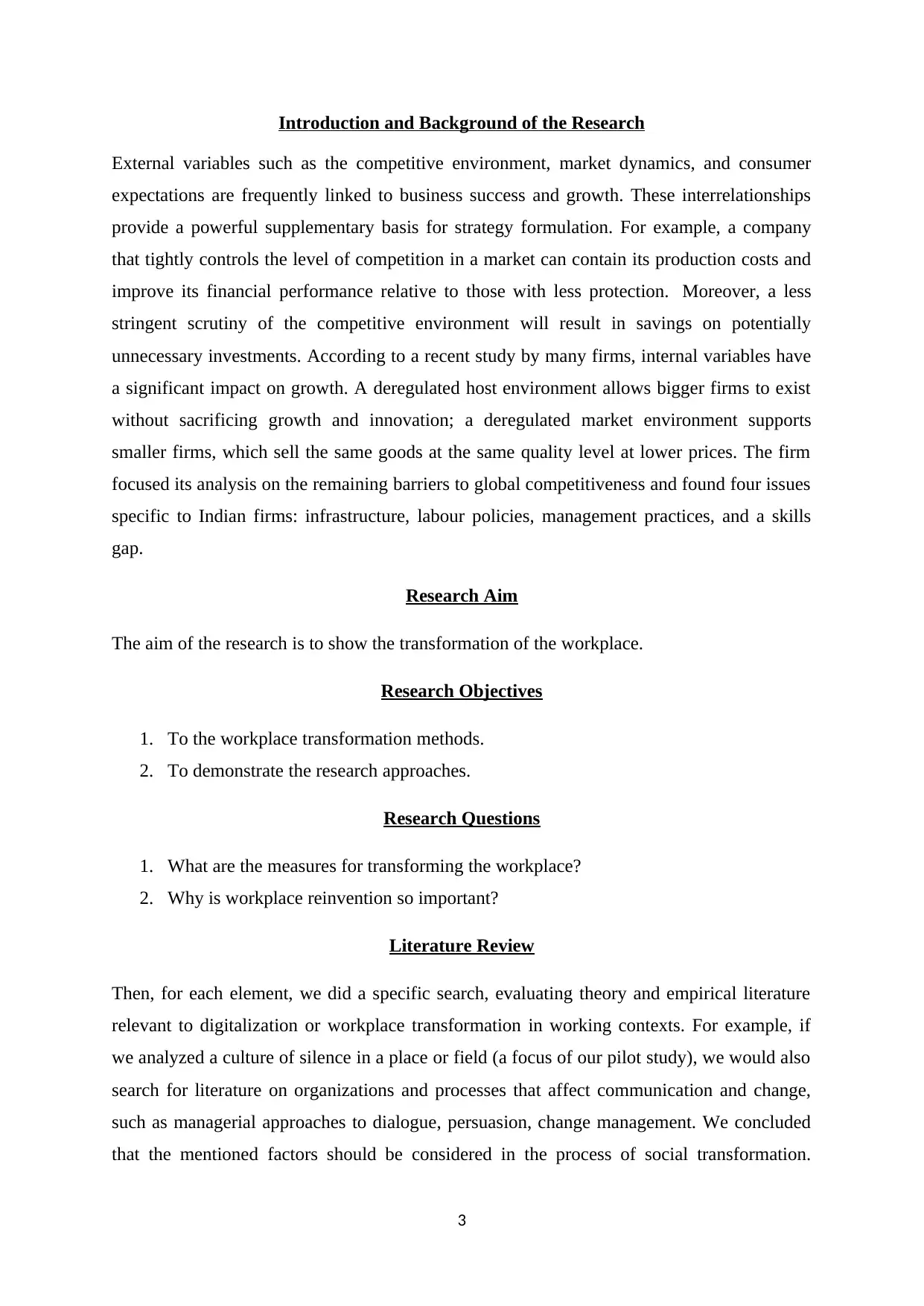
Introduction and Background of the Research
External variables such as the competitive environment, market dynamics, and consumer
expectations are frequently linked to business success and growth. These interrelationships
provide a powerful supplementary basis for strategy formulation. For example, a company
that tightly controls the level of competition in a market can contain its production costs and
improve its financial performance relative to those with less protection. Moreover, a less
stringent scrutiny of the competitive environment will result in savings on potentially
unnecessary investments. According to a recent study by many firms, internal variables have
a significant impact on growth. A deregulated host environment allows bigger firms to exist
without sacrificing growth and innovation; a deregulated market environment supports
smaller firms, which sell the same goods at the same quality level at lower prices. The firm
focused its analysis on the remaining barriers to global competitiveness and found four issues
specific to Indian firms: infrastructure, labour policies, management practices, and a skills
gap.
Research Aim
The aim of the research is to show the transformation of the workplace.
Research Objectives
1. To the workplace transformation methods.
2. To demonstrate the research approaches.
Research Questions
1. What are the measures for transforming the workplace?
2. Why is workplace reinvention so important?
Literature Review
Then, for each element, we did a specific search, evaluating theory and empirical literature
relevant to digitalization or workplace transformation in working contexts. For example, if
we analyzed a culture of silence in a place or field (a focus of our pilot study), we would also
search for literature on organizations and processes that affect communication and change,
such as managerial approaches to dialogue, persuasion, change management. We concluded
that the mentioned factors should be considered in the process of social transformation.
3
External variables such as the competitive environment, market dynamics, and consumer
expectations are frequently linked to business success and growth. These interrelationships
provide a powerful supplementary basis for strategy formulation. For example, a company
that tightly controls the level of competition in a market can contain its production costs and
improve its financial performance relative to those with less protection. Moreover, a less
stringent scrutiny of the competitive environment will result in savings on potentially
unnecessary investments. According to a recent study by many firms, internal variables have
a significant impact on growth. A deregulated host environment allows bigger firms to exist
without sacrificing growth and innovation; a deregulated market environment supports
smaller firms, which sell the same goods at the same quality level at lower prices. The firm
focused its analysis on the remaining barriers to global competitiveness and found four issues
specific to Indian firms: infrastructure, labour policies, management practices, and a skills
gap.
Research Aim
The aim of the research is to show the transformation of the workplace.
Research Objectives
1. To the workplace transformation methods.
2. To demonstrate the research approaches.
Research Questions
1. What are the measures for transforming the workplace?
2. Why is workplace reinvention so important?
Literature Review
Then, for each element, we did a specific search, evaluating theory and empirical literature
relevant to digitalization or workplace transformation in working contexts. For example, if
we analyzed a culture of silence in a place or field (a focus of our pilot study), we would also
search for literature on organizations and processes that affect communication and change,
such as managerial approaches to dialogue, persuasion, change management. We concluded
that the mentioned factors should be considered in the process of social transformation.
3
⊘ This is a preview!⊘
Do you want full access?
Subscribe today to unlock all pages.

Trusted by 1+ million students worldwide
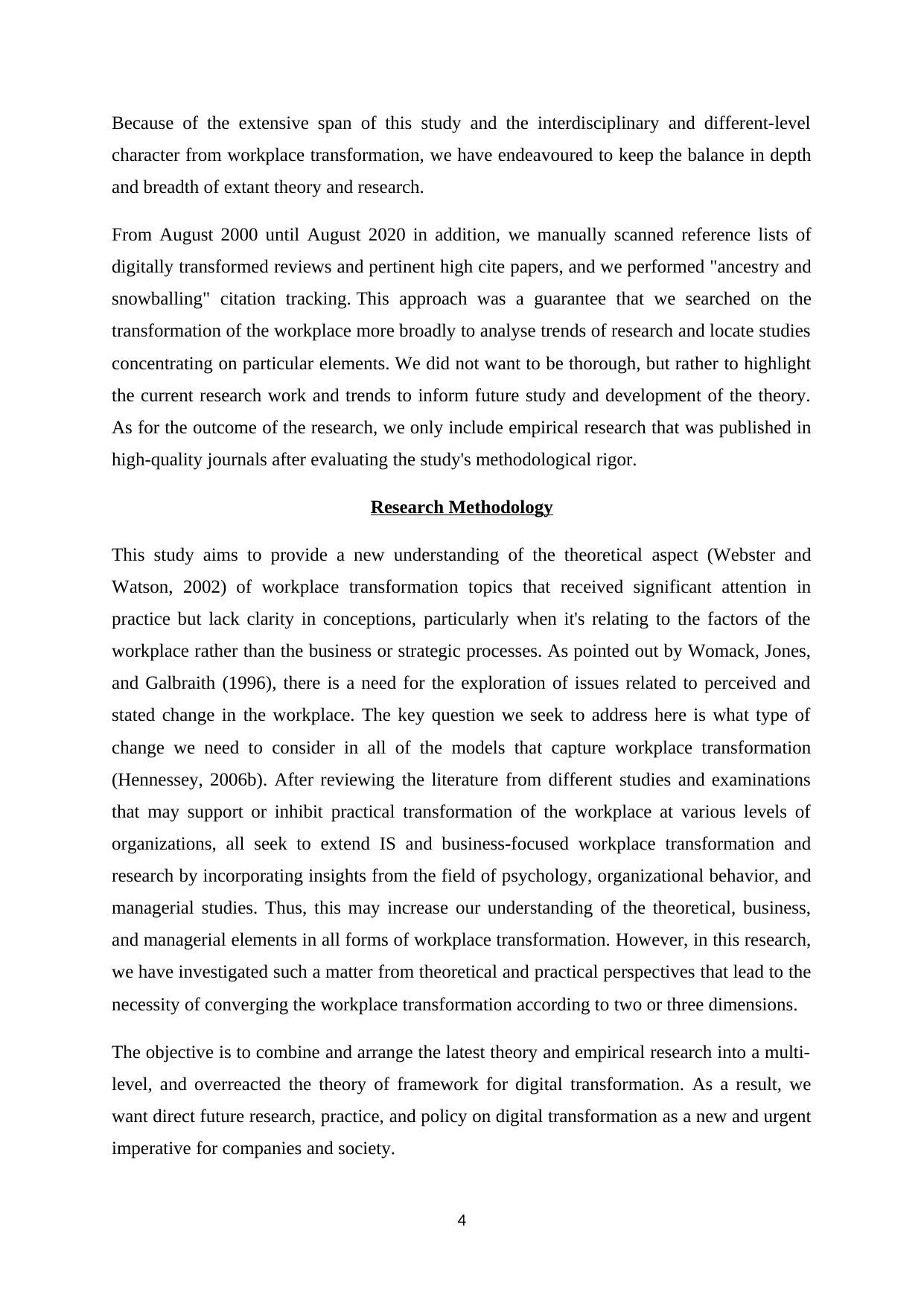
Because of the extensive span of this study and the interdisciplinary and different-level
character from workplace transformation, we have endeavoured to keep the balance in depth
and breadth of extant theory and research.
From August 2000 until August 2020 in addition, we manually scanned reference lists of
digitally transformed reviews and pertinent high cite papers, and we performed "ancestry and
snowballing" citation tracking. This approach was a guarantee that we searched on the
transformation of the workplace more broadly to analyse trends of research and locate studies
concentrating on particular elements. We did not want to be thorough, but rather to highlight
the current research work and trends to inform future study and development of the theory.
As for the outcome of the research, we only include empirical research that was published in
high-quality journals after evaluating the study's methodological rigor.
Research Methodology
This study aims to provide a new understanding of the theoretical aspect (Webster and
Watson, 2002) of workplace transformation topics that received significant attention in
practice but lack clarity in conceptions, particularly when it's relating to the factors of the
workplace rather than the business or strategic processes. As pointed out by Womack, Jones,
and Galbraith (1996), there is a need for the exploration of issues related to perceived and
stated change in the workplace. The key question we seek to address here is what type of
change we need to consider in all of the models that capture workplace transformation
(Hennessey, 2006b). After reviewing the literature from different studies and examinations
that may support or inhibit practical transformation of the workplace at various levels of
organizations, all seek to extend IS and business-focused workplace transformation and
research by incorporating insights from the field of psychology, organizational behavior, and
managerial studies. Thus, this may increase our understanding of the theoretical, business,
and managerial elements in all forms of workplace transformation. However, in this research,
we have investigated such a matter from theoretical and practical perspectives that lead to the
necessity of converging the workplace transformation according to two or three dimensions.
The objective is to combine and arrange the latest theory and empirical research into a multi-
level, and overreacted the theory of framework for digital transformation. As a result, we
want direct future research, practice, and policy on digital transformation as a new and urgent
imperative for companies and society.
4
character from workplace transformation, we have endeavoured to keep the balance in depth
and breadth of extant theory and research.
From August 2000 until August 2020 in addition, we manually scanned reference lists of
digitally transformed reviews and pertinent high cite papers, and we performed "ancestry and
snowballing" citation tracking. This approach was a guarantee that we searched on the
transformation of the workplace more broadly to analyse trends of research and locate studies
concentrating on particular elements. We did not want to be thorough, but rather to highlight
the current research work and trends to inform future study and development of the theory.
As for the outcome of the research, we only include empirical research that was published in
high-quality journals after evaluating the study's methodological rigor.
Research Methodology
This study aims to provide a new understanding of the theoretical aspect (Webster and
Watson, 2002) of workplace transformation topics that received significant attention in
practice but lack clarity in conceptions, particularly when it's relating to the factors of the
workplace rather than the business or strategic processes. As pointed out by Womack, Jones,
and Galbraith (1996), there is a need for the exploration of issues related to perceived and
stated change in the workplace. The key question we seek to address here is what type of
change we need to consider in all of the models that capture workplace transformation
(Hennessey, 2006b). After reviewing the literature from different studies and examinations
that may support or inhibit practical transformation of the workplace at various levels of
organizations, all seek to extend IS and business-focused workplace transformation and
research by incorporating insights from the field of psychology, organizational behavior, and
managerial studies. Thus, this may increase our understanding of the theoretical, business,
and managerial elements in all forms of workplace transformation. However, in this research,
we have investigated such a matter from theoretical and practical perspectives that lead to the
necessity of converging the workplace transformation according to two or three dimensions.
The objective is to combine and arrange the latest theory and empirical research into a multi-
level, and overreacted the theory of framework for digital transformation. As a result, we
want direct future research, practice, and policy on digital transformation as a new and urgent
imperative for companies and society.
4
Paraphrase This Document
Need a fresh take? Get an instant paraphrase of this document with our AI Paraphraser
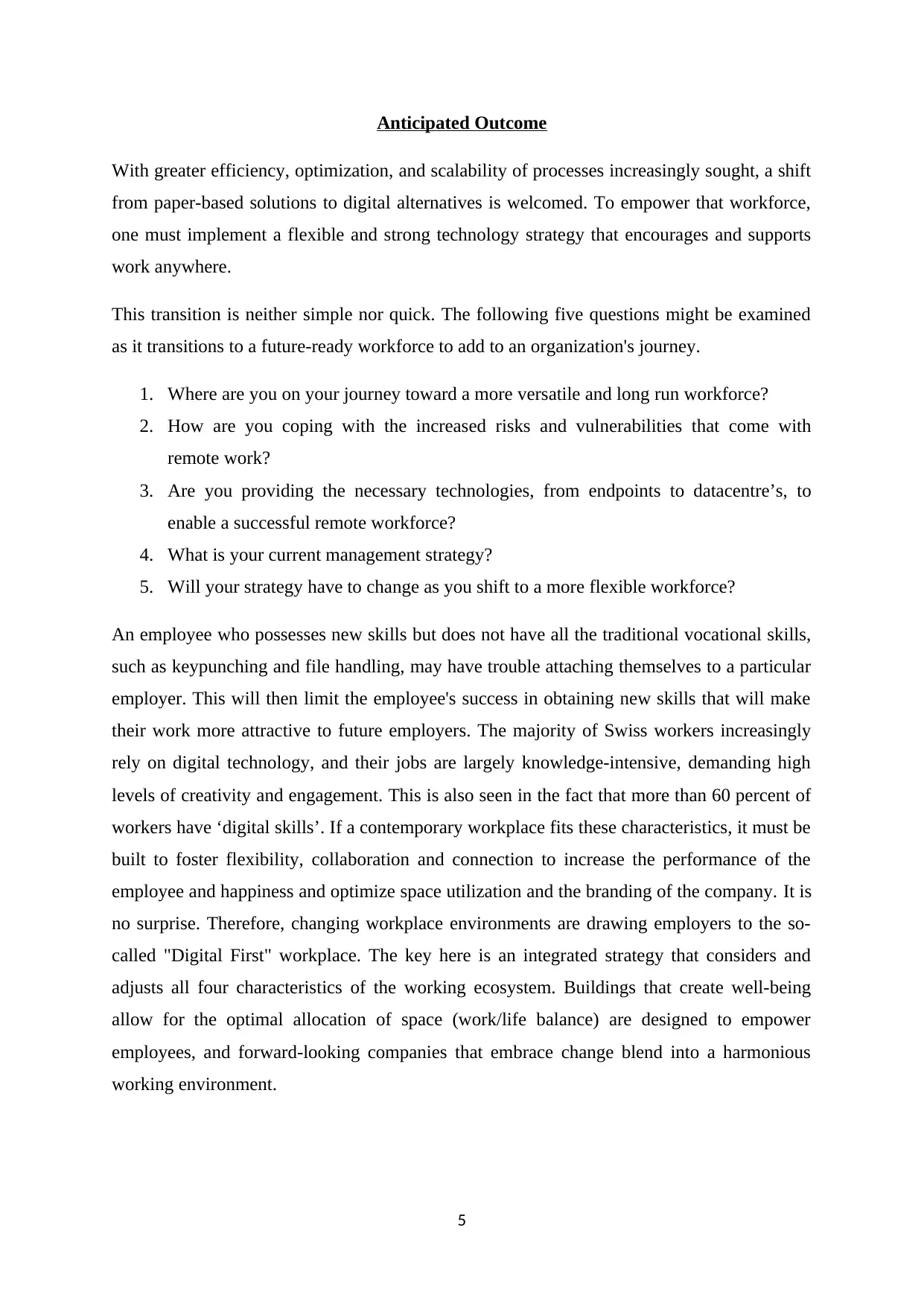
Anticipated Outcome
With greater efficiency, optimization, and scalability of processes increasingly sought, a shift
from paper-based solutions to digital alternatives is welcomed. To empower that workforce,
one must implement a flexible and strong technology strategy that encourages and supports
work anywhere.
This transition is neither simple nor quick. The following five questions might be examined
as it transitions to a future-ready workforce to add to an organization's journey.
1. Where are you on your journey toward a more versatile and long run workforce?
2. How are you coping with the increased risks and vulnerabilities that come with
remote work?
3. Are you providing the necessary technologies, from endpoints to datacentre’s, to
enable a successful remote workforce?
4. What is your current management strategy?
5. Will your strategy have to change as you shift to a more flexible workforce?
An employee who possesses new skills but does not have all the traditional vocational skills,
such as keypunching and file handling, may have trouble attaching themselves to a particular
employer. This will then limit the employee's success in obtaining new skills that will make
their work more attractive to future employers. The majority of Swiss workers increasingly
rely on digital technology, and their jobs are largely knowledge-intensive, demanding high
levels of creativity and engagement. This is also seen in the fact that more than 60 percent of
workers have ‘digital skills’. If a contemporary workplace fits these characteristics, it must be
built to foster flexibility, collaboration and connection to increase the performance of the
employee and happiness and optimize space utilization and the branding of the company. It is
no surprise. Therefore, changing workplace environments are drawing employers to the so-
called "Digital First" workplace. The key here is an integrated strategy that considers and
adjusts all four characteristics of the working ecosystem. Buildings that create well-being
allow for the optimal allocation of space (work/life balance) are designed to empower
employees, and forward-looking companies that embrace change blend into a harmonious
working environment.
5
With greater efficiency, optimization, and scalability of processes increasingly sought, a shift
from paper-based solutions to digital alternatives is welcomed. To empower that workforce,
one must implement a flexible and strong technology strategy that encourages and supports
work anywhere.
This transition is neither simple nor quick. The following five questions might be examined
as it transitions to a future-ready workforce to add to an organization's journey.
1. Where are you on your journey toward a more versatile and long run workforce?
2. How are you coping with the increased risks and vulnerabilities that come with
remote work?
3. Are you providing the necessary technologies, from endpoints to datacentre’s, to
enable a successful remote workforce?
4. What is your current management strategy?
5. Will your strategy have to change as you shift to a more flexible workforce?
An employee who possesses new skills but does not have all the traditional vocational skills,
such as keypunching and file handling, may have trouble attaching themselves to a particular
employer. This will then limit the employee's success in obtaining new skills that will make
their work more attractive to future employers. The majority of Swiss workers increasingly
rely on digital technology, and their jobs are largely knowledge-intensive, demanding high
levels of creativity and engagement. This is also seen in the fact that more than 60 percent of
workers have ‘digital skills’. If a contemporary workplace fits these characteristics, it must be
built to foster flexibility, collaboration and connection to increase the performance of the
employee and happiness and optimize space utilization and the branding of the company. It is
no surprise. Therefore, changing workplace environments are drawing employers to the so-
called "Digital First" workplace. The key here is an integrated strategy that considers and
adjusts all four characteristics of the working ecosystem. Buildings that create well-being
allow for the optimal allocation of space (work/life balance) are designed to empower
employees, and forward-looking companies that embrace change blend into a harmonious
working environment.
5
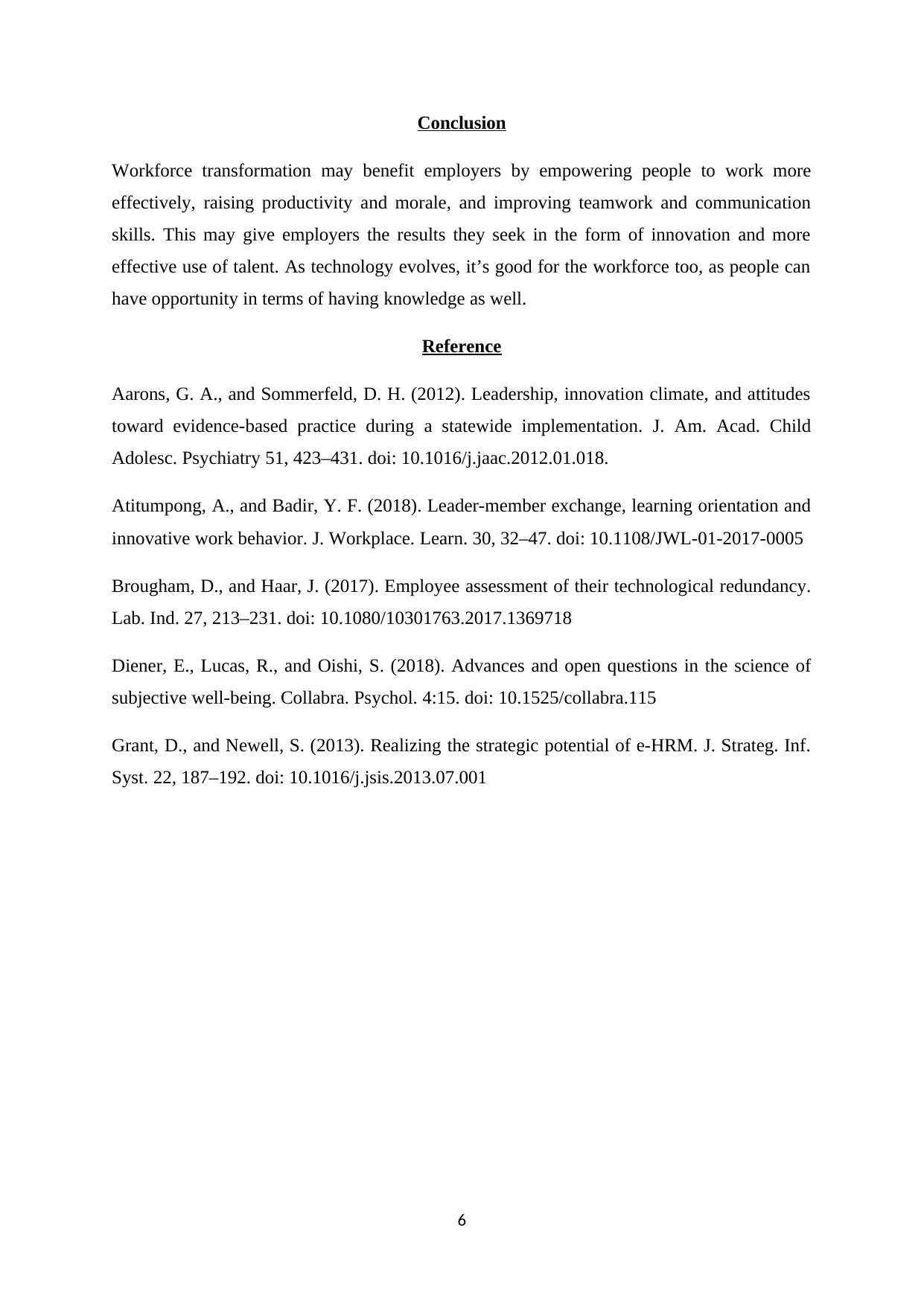
Conclusion
Workforce transformation may benefit employers by empowering people to work more
effectively, raising productivity and morale, and improving teamwork and communication
skills. This may give employers the results they seek in the form of innovation and more
effective use of talent. As technology evolves, it’s good for the workforce too, as people can
have opportunity in terms of having knowledge as well.
Reference
Aarons, G. A., and Sommerfeld, D. H. (2012). Leadership, innovation climate, and attitudes
toward evidence-based practice during a statewide implementation. J. Am. Acad. Child
Adolesc. Psychiatry 51, 423–431. doi: 10.1016/j.jaac.2012.01.018.
Atitumpong, A., and Badir, Y. F. (2018). Leader-member exchange, learning orientation and
innovative work behavior. J. Workplace. Learn. 30, 32–47. doi: 10.1108/JWL-01-2017-0005
Brougham, D., and Haar, J. (2017). Employee assessment of their technological redundancy.
Lab. Ind. 27, 213–231. doi: 10.1080/10301763.2017.1369718
Diener, E., Lucas, R., and Oishi, S. (2018). Advances and open questions in the science of
subjective well-being. Collabra. Psychol. 4:15. doi: 10.1525/collabra.115
Grant, D., and Newell, S. (2013). Realizing the strategic potential of e-HRM. J. Strateg. Inf.
Syst. 22, 187–192. doi: 10.1016/j.jsis.2013.07.001
6
Workforce transformation may benefit employers by empowering people to work more
effectively, raising productivity and morale, and improving teamwork and communication
skills. This may give employers the results they seek in the form of innovation and more
effective use of talent. As technology evolves, it’s good for the workforce too, as people can
have opportunity in terms of having knowledge as well.
Reference
Aarons, G. A., and Sommerfeld, D. H. (2012). Leadership, innovation climate, and attitudes
toward evidence-based practice during a statewide implementation. J. Am. Acad. Child
Adolesc. Psychiatry 51, 423–431. doi: 10.1016/j.jaac.2012.01.018.
Atitumpong, A., and Badir, Y. F. (2018). Leader-member exchange, learning orientation and
innovative work behavior. J. Workplace. Learn. 30, 32–47. doi: 10.1108/JWL-01-2017-0005
Brougham, D., and Haar, J. (2017). Employee assessment of their technological redundancy.
Lab. Ind. 27, 213–231. doi: 10.1080/10301763.2017.1369718
Diener, E., Lucas, R., and Oishi, S. (2018). Advances and open questions in the science of
subjective well-being. Collabra. Psychol. 4:15. doi: 10.1525/collabra.115
Grant, D., and Newell, S. (2013). Realizing the strategic potential of e-HRM. J. Strateg. Inf.
Syst. 22, 187–192. doi: 10.1016/j.jsis.2013.07.001
6
⊘ This is a preview!⊘
Do you want full access?
Subscribe today to unlock all pages.

Trusted by 1+ million students worldwide
1 out of 6
Related Documents
Your All-in-One AI-Powered Toolkit for Academic Success.
+13062052269
info@desklib.com
Available 24*7 on WhatsApp / Email
![[object Object]](/_next/static/media/star-bottom.7253800d.svg)
Unlock your academic potential
Copyright © 2020–2025 A2Z Services. All Rights Reserved. Developed and managed by ZUCOL.





